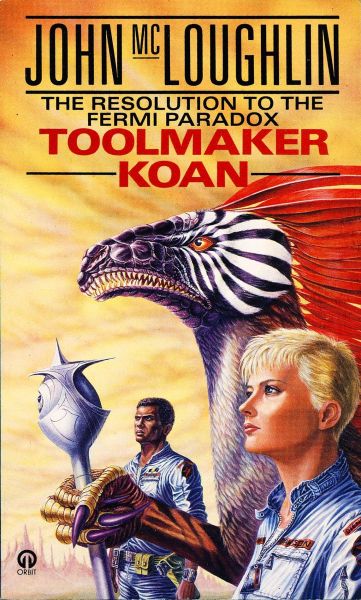Visions Of The Things To Be
Toolmaker Koan
By John C. McLoughlin

1 Jun, 2023
John C. McLoughlin’s 1987 Toolmaker Koan is a stand-alone science fiction novel.
Only a few million people died during the One-Day War and the Disturbance that followed. To preclude further hostilities, the overcrowded, poisoned Earth was divided between the Greater Columbian Alliance (essentially North and South America) and the United People’s Democratic Republics of Africa and Eurasia (everyone else). Both sides are mutually hostile, vigilant, and heavily armed — but peace is ensured. The alternative, after all, is total species extinction.
Far out towards the Oort Cloud, a Democratic Republics’ space probe discovers a curious object. A third party has entered the game. This new faction is alien.
The Marxists assemble a team from the population of Engels, their space habitat, before dispatching them on Dienbienphu, an orbiting weapons platform that has been hastily converted to a nuclear-powered rocket. The Alliance, fearing the consequences should their enemies monopolize alien contact, assemble their own crew and launch Expediter, an equally advanced, just as heavily armed spacecraft towards the distant alien object. Expediter is trailed by a Democratic Republics space probe.
Once in the vicinity of the object, the Dienbienphu prudently sends a signal to the probe to detonate its warhead. Unaware that a wavefront of doom is coming their way, Expediter fires its impressive array of long-range weapons at the Dienbienphu. Both sides triumph! The survivors on both sides can die knowing that their enemy’s ship is just as crippled and that those who did not die immediately are certain to expire from acute radiation sickness.
Luckily for the four surviving humans — Oruna Benai and Jennifer Dawson from Dienbienphu, Pike Muir and Jimbob Corson from Expediter—the alien object is a fully functional artificial intelligence who has a use for living humans. The AI politely introduces itself as “Charon” before saving the humans.
Charon was created by a long-dead alien civilization shortly before their self-inflicted demise. It has searched the galaxy for other tool-using races. Every time it detected the electromagnetic emissions of advanced technology, the civilization producing them died of self-inflicted wounds before Charon could reach them. It seems that advanced civilizations always have the means to destroy themselves but never the prudence to avoid doing so. This is the Toolmaker Koan.
Charon proposes an experiment. It did not so much save the quartet as it created undamaged duplicates with sufficient continuity of consciousness to believe that they are Oruna, Jennifer, Pike, and Corson. The same technology can be used to revive members of a long-dead civilization Charon encountered tens of millions of years ago. Tool-using species being so ephemeral, no two have ever met before. Perhaps partnership is the key to survival!
The Whileelin are large, obligate carnivores with an entrenched caste system. To human eyes, they look ferociously avian, with overtones of the saurian. While they bear no particular hostility to humans and are entirely capable of conversing politely with the human ambassadors, the Whileelin place no value on other species. Earth is virtually identical to their lost home world, right down to the anomalously large Moon. It would be a perfect home for the Whileelin. The humans will have to go, of course.
Conveniently for the Whileelin, they will not have to work hard to remove humanity. First contact has acerbated hostilities on Earth. Resolute officers on both sides pursue their duty without hesitation. Six billion people (and untold numbers of other animals) die. Only the ten thousand humans in humanity’s two space habitats survive … at least, until the Whileelin can reach them.
~oOo~
Curiously, the Baen edition for this novel had a cover that was not unspeakably terrible. One can easily imagine someone looking at it without their eyeballs spontaneously melting.

In Charon’s defense, it freely admits that the billions of years of conflict between its programmed imperatives and the reality in which it finds itself have driven it quite mad. If its bold scheme seems doomed from the outset, this is because the poor machine is incapable of coming up with a better idea. Unfortunate, because being unable to arrive at a constructive course of action does not stop it from trying to fix what it broke. It is possible the Toolmaker Koan applies to Charon as well.
John C. McLoughlin wrote two SF novels, this one and 1983’s The Helix and Sword. Both concern themselves with human civilizations that render the Earth largely uninhabitable. While I have not reread Helix in years and cannot comment on it (yet), the book in hand may offer an explanation for the author’s absence. The prose is sufficiently leaden as to protect humans from the effects of nuclear warfare and the characters so minor as to barely justify naming them. The Cold War conflict is cartoonish. The novel has a completely unearned happy ending, as though the author did not quite have the resolve to follow his logic to its inevitable conclusion.
All of which is a pity, because there are some interesting ideas in the novel, ideas that would have benefited from a more skilled depiction. As it was, the infodumps successfully kept my attention throughout the novel. I can only imagine how much better the reading experience would have been had plot, prose, and characters been more engaging.
As far as I can tell, Toolmaker Koan is out of print. I did spot an entry for the Reagan-era Baen mass market at Amazon but I am pretty sure it was spurious. Baen doesn’t list the book on their site.
